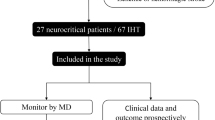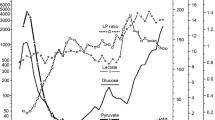Summary
27 Patients following severe brain injury were studied with regard to metabolic alterations. Metabolic rate was calculated from measured RQ, respiratory minute volume and oxygen consumption, as soon as the patient was able to breathe spontaneously. Catabolism was defined by determination of N-balance. It was concluded that metabolism following cerebral injury is particularly enhanced compared to common trauma. The neurological course of patients, who after midbrain syndrome recovered in contrast to those who developed apallic syndrome had little influence on metabolic rates, however, it distinctly seemed to modify catabolism. Thus catabolism throughout the apallic phase was found to be higher. The requirements for a favourable recovery from severe brain injury were defined as a well balanced nitrogen regime apart from a high amount of carbohydrate and fat calories.
Similar content being viewed by others
References
Abbott, W. E., Albertsen, K.: The effect of starvation, infection and injury on the metabolic processes and body composition. Ann. N. Y. Acad. Sci 110, 941 (1963)
Allison, S. P., Hinton, P., Chamberlain, M. J.: Intravenous glucose tolerance, insulin and FFA levels in burned patiens. Lancet 1113 (1968)
Bauer, B. L., Pia, H. W.: Parenterale Ernährung in der Neurochirurgie. In: Lang, K., Frey, R., Halmagyi, M.: Springer, Berlin - New York 1966
Berg, G.: Discussion at the: 5. Gemeinsame Tagung der Deutschen und Österreichischen Arbeitsgemeinschaft für Internistische Intensivmedizin, Wien, Sept. 1973.
Birke, G., Duner, H., Liljedahl, S. 0., Pernow, B., Platin, L. 0., Troell, L.: Histamine, Catecholamines and Adrenocortical Steroids on Burns. Acta. chir. Stand. 114, 87 (1958)
Birke, G., Carlson, L. A., Liljedahl, S. O.: Lipid metabolism and trauma III. Acta. Med. Scand. 178, 337 (1965)
Bunte, H.: Klinik der postoperativen Störung des N-Metabolismus und Elektrolythaushaltes. Band: Stoffwechsel, Frey, Kern, Mayrhofer 58, 99 (1972)
Calloway, D. H., Spector, H.: Nitrogen balance as related to caloric and protein intake in active young men. Amer. J. Clin. Nutr. 2, 405 (1954)
Carlson, L. A.: Deposition, mobilisation and utilization of fat. Acta. chir. stand. Suppl. 325, 5 (1964)
Carlson, L. A., Liljedahl, S. O.: Effect of treatment with intravenous fat emulsions on plasma lipids, proteins and clinical condition of burned patients. Acta. Clin. Stand. 137, 123 (1971)
Cope, O., Nathanson, I. T., Rourke, G. M., Wilson, H.: Symposium on the management of grave burns at Massachusetts General
Cuthbertson, D. P., Tilstone, W. J.: Metabolism during the post-injury period. Adv. clip. Chem. 12, 1 (1969)
Cuthbertson, D. P., Fell, G. S., Smith, C. M., Tilstone. W. J.: Nutrition in the Post-Traumatic Period. Nutr. Metabol. Vol. 14, Suppl. 92, 1972.
Deligne, P.: Le retentissement metabolique du traumatisme cerebral le catabolisme. Ann. Franc. Special 1, 150–157 (1973)
Fleck, A., Munro, H. N.: Protein metabolism after injury. Metabolism 12, 783 (1963)
Frankson, C., Gemzell, C. A., von Euler, U. S.: Cortical and meduallary adrenal activity in surgical and allied conditions. J. clip. Endocrinol. 14, 608 (1954)
Gerstenbrand, F.: Das traumatische apallische Syndrom. Springer Verlag, Wien - New York 1967
Gerstenbrand, F., Galanti, T.: Die Bedeutung der Ernährung für die Prognose des apallischen Syndroms. In: Parenterale Ernährung, S. 166–171, Verlag H. Huber 1972
Goodall, Mc. C., Stone, C., Haynes, B. W., Jr.: Urinary output of Adrenaline and Noradrenaline in severe Thermal Burns. Surgery 145, 479 (1957)
Grashchenkov, N. L, Boeva, E. M., Irger, J. M., Kassil, G. N., Kamenetskaya, B. L, Fishman, M. N.: Clinical and pathophysiological analysis of acute closed cranio-cerebral injury. In: Proceedings of the third International Congress of Neurological Surgery. Copenhagen, 23–27 August, International Congress, Series n° 110, Excerpta Medico Foundation, 119–159 (1965)
Haider, W., Lackner, F., Skudrzyk, L, Tonczar, L.: Das Verhalten der Kohlenhydrattoleranz bei gleichzeitiger Verabfolgung von hohen Dextrose- und Insulinmengen zur parenteralen Ernährung von Intensivpatienten mit gesteigertem Kalorienbedarf. 1973, in print
Haider, W., Steinbereithner, K.: Das Verhalten der Lipid-fraktionen im Plasma während langdauernder parenteraler Fettzufuhr bei Patienten mit Schwerem Schädel-Hirn-Trauma (SHT). Herausgegeben von G. Hartmann und H. Berger, Verlag Hans Huber, Bern, Stuttgart, Wien 1972
Hallberg, D., Schuberta, 0., Wretlind, A.: Parenterale Ernährung. Dt. Übersetzung aus: Ldkartidningen 65, 4563 (1968)
Huguenard, P., Roujas, F.: Essai clinique systematique d'un nouvelle assoziation des L amino acides. An. Anesth. Franc. XI, I, 31 (1970)
25.Jellinger, K.: Zur Pathogenese und klinischen Bedeutung von Hirnstammschäden nach gedecktem SHT. Acta 25 Conv. Neuro. Psych et EEG. Hung. Budapest 303, 1966
Kinney, J. M.: Protein metabolism in human pathological states: The effect of injury on human protein metabolism in “Symposium on Protein Metabolism. Influence of growth hormone on anabolic steroids and nutrition in health and disease”. F.Grossed., p. 275, Springer-Verlag, Berlin 1962
Lorenz, R.: Wirkungen intracranieller raumfordernder Prozesse auf den Verlauf von Blutdruck und Pulsfrequenz. Acta neurochir. Suppl 20, Springer-Verlag 1973
Peters, G.: Morphologische Forschung in der Neurologie und Psychiatrie. Nervenarzt 37, 429 (1966)
Schlick, W., Kloucek, H., Lageder, H., Irsigler, K.: Energieumsätze unter Nulldiät. Medizin und Ernährung 13, 215 (1972)
Steinbereithner, K.: Spezielle Fragen der künstlichen Erndhrung schwer Schädel-Hirn-Verletzter. Fortschritte der parenteralen Ernährung. Symp. d. Internat. Soc. of Parenteral Nutrition, Pallas-Verlag, Lochham bei München, S. 96, 1966 Prof. Dr. Otto Mayrhofer
Author information
Authors and Affiliations
Rights and permissions
About this article
Cite this article
Haider, W., Lackner, F., Schlick, W. et al. Metabolic changes in the course of severe acute Brain Damage. Europ. J. Intensive Care Med 1, 19–26 (1975). https://doi.org/10.1007/BF00735865
Issue Date:
DOI: https://doi.org/10.1007/BF00735865




